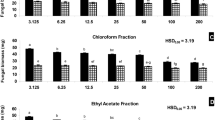Abstract
9-Oxo-agerophorone is a cadinene sesquiterpene, isolated from the leaves of Eupatorium adenophorum. This study evaluated the antimicrobial activity of 9-oxo-agerophorone against three strains of Ralstonia solanacearum and four pathogenic fungi, with an emphasis on the growth and morphogenesis of fungi at scanning electron microscopy level. The determination of minimal inhibitory concentrations demonstrated that 9-oxo-agerophorone exhibited moderate bactericidal activity against R. solanacearum strains. However, antifungal assays showed that 9-oxo-agerophorone has strong toxicity against Fusarium oxysporum, Bipolaris sorokiniana, Fusarium proliferatum, and Alternaria tenuissima with median lethal concentrations ranging from 0.476 to 0.357 mg ml−1 after 4 days incubation on potato dextrose agar medium. The main changes observed by scanning electron microscopy after 9-oxo-agerophorone treatment were fungal cell wall shrinkage, loss of conidia, formation of short branches in F. oxysporum and F. proliferatum, collapse, broken cell walls, and increased hyphae diameter in A. tenuissima. The tested treatments were also effective in inhibiting spore germination of Fusarium species. The results indicated that 9-oxo-agerophorone is a potential candidate as a phytotherapeutic agent for soil-borne fungal diseases.



Similar content being viewed by others
References
Ahluwalia V, Sisodia R, Walia S, Sati OP, Kumar J, Kundu A (2014) Chemical analysis of essential oils of Eupatorium adenophorum and their antimicrobial, antioxidant and phytotoxic properties. J Pest Sci 87:341–349
Balandrin MF, Klocke JA, Wurtele ES, Bollinger WH (1985) Natural plant chemicals: sources of industrial and medicinal materials. Science 228:1154–1160
Baruah NC, Sarma JC, Sarma S, Sharma RP (1994) Seed germination and growth inhibitory cadinenes from Eupatorium adenophorum spreng. J Chem Ecol 20:1885–1892
Bowers WS, Ortego F, You X, Evans PH (1993) Insect repellents from the Chinese prickly ash Zanthoxylum bungeanum. J Nat Prod 56:935–938
Buccellato L, Byrne MJ, Witkowski ETF (2012) Interactions between a stem gall fly and a leaf-spot pathogen in the biological control of Ageratina adenophora. Biol Control 61:222–229
Eloff JN (1998) A sensitive and quick microplate method to determine the minimal inhibitory concentration of plant extracts for bacteria. Plant Med 64:711–713
Giordani R, Cardenas ML, Moulin-Traffort J, Regli P (1996) Fungicidal activity of latex sap from Carica papaya and antifungal effect of D (+)-glucosamine on Candida albicans growth. Mycoses 39:103–110
Gulluce M, Adiguzel A, Ogutcu H, Sengul M, Sahin F (2004) Antimicrobial effects of Quercus ilex L. extract. Phytother Res 18:208–211
Gulluce M, Sahin F, Sokmen M, Ozer H, Daferera D, Sokmen A, Ozkan H (2007) Antimicrobial and antioxidant properties of the essential oils and methanol extract from Mentha longifolia L. ssp. longifolia. Food Chem 103:1449–1456
He L, Hou J, Gan M, Shi J, Chantrapromma S, Fun HK, Sung HHY (2008) Cadinane sesquiterpenes from the leaves of Eupatorium adenophorum. J Nat Prod 71:1485–1488
Helander IM, Alakomi H-L, Latva-Kala K, Mattila-Sandholm T, Pol I, Smid EJ, Wright A (1998) Characterization of the action of selected essential oil components on Gram-negative bacteria. J Agric Food Chem 46:3590–3595
Ho SH, Koh L, Ma Y, Huang Y, Sim KY (1996) The oil of garlic, Allium sativum L. (Amaryllidaceae), as a potential grain protectant against Tribolium castaneum (Herbst) and Sitophilus zeamais Motsch. Postharvest Biol Technol 9:41–48
Knobloch K, Pauli A, Iberl B, Weigand H, Weis N (1989) Antibacterial and antifungal properties of essential oil components. J Essent Oil Res 1:119–128
Kundu A, Saha S, Sureshwalia SNA, Kumar J, Annapurna K (2013) Cadinene sesquiterpenes from Eupatorium adenophorum and their antifungal activity. J Environ Sci Health B 48:516–522
Kundu A, Saha S, Walia S, Ahluwalia V, Kaur C (2013) Antioxidant potential of essential oil and cadinene sesquiterpenes of Eupatorium adenophorum. Toxicol Environ Chem 95:127–137
Li Y, Li J, Li Y, Wang X, Cao A (2013) Antimicrobial constituents of the leaves of Mikania micrantha H. B. K. PloS One 8:1–10
Mu LY (1994) The research methods of plant chemical protection. Chinese Agricultural Press, Beijing
Ouyang C, Liu X, Liu Q, Bai J, Li H, Li Y, Guo M (2015) Toxicity assessment of cadinene sesquiterpenes from Eupatorium adenophorum in mice. Nat Prod Bioprospect 5:29–36
Proksch P, Wray V, Isman MB, Rahaus I (1990) Ontogenetic variation of biologically active natural products in Ageratina adenophora. Phytochemistry 29:453–457
Romagnoli C, Bruni R, Andreotti E, Rai MK, Vicentini CB, Mares D (2005) Chemical characterization and antifungal activity of essential oil of capitula from wild Indian Tagetes patula L. Protoplasma 225:57–65
Sharma OP, Dawra RK, Kurade NP, Sharma PD (1998) A review of the toxicosis and biological properties of the genus Eupatorium. Nat Toxins 6:1–14
Sun X, Lu Z, Sang W (2004) Review on studies of Eupatorium adenophorum—an important invasive species in China. J For Res 15:319–322
Tolouee M, Alinezhad S, Saberi R, Eslamifar A, Zad SJ, Jaimand K, Razzaghi-Abyaneh M (2010) Effect of Matricaria chamomilla L. flower essential oil on the growth and ultrastructure of Aspergillus niger van Tieghem. Int J Food Microbiol 139:127–133
Tripathi A, Sharma N, Sharma V (2009) In vitro efficacy of Hyptis suaveolens L. (Poit.) essential oil on growth and morphogenesis of Fusarium oxysporum f.sp. gladioli (Massey) Snyder & Hansen. World J Microb Biotechnol 25:503–512
Wang R, Wang Y (2006) Invasion dynamics and potential spread of the invasive alien plant species Ageratina adenophora (Asteraceae) in China. Divers Distrib 12:397–408
Zhao X, Zheng G, Niu X, Li W, Wang F, Li S (2009) Terpenes from Eupatorium adenophorum and their allelopathic effects on Arabidopsis seeds germination. J Agric Food Chem 57:478–482
Zhu W, Cao A, Yan D, Li L, Liu X, Guo Z, Chen G (2013) Evaluation the efficacy and influence of herbicides on flowering and fruitification of Eupatorium adenophorum Spreng. Ecol Environ Sci 22:820–825
Acknowledgments
We thank Dr. Melanie Miller for providing language help. This work was supported by Special Fund for Agro-scientific Research in the Public Interest of China (No. 20110327).
Author information
Authors and Affiliations
Corresponding author
Rights and permissions
About this article
Cite this article
Liu, X., Ouyang, C., Li, Y. et al. Evaluation of the antimicrobial activity of 9-oxo-agerophorone against soil borne pathogens. J Plant Dis Prot 123, 163–170 (2016). https://doi.org/10.1007/s41348-016-0022-3
Received:
Accepted:
Published:
Issue Date:
DOI: https://doi.org/10.1007/s41348-016-0022-3




